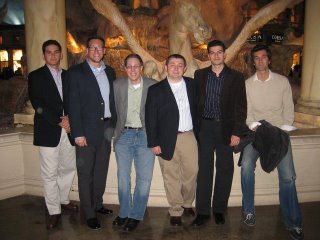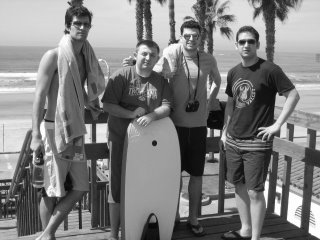Sorry for the long break for you avid readers out there...All 2 of you. Anyways I shouldn't apologize I'm writing this for myself anyway so to heck with you haha. But I did have spring break and a LOAD of work to do. Pretty interesting article about my program just came out in the Financial Engineering News.
http://www.fenews.com/fen48/spec-report/ksu/kent-state.html. On a trading note, our sim has been a little buggy also lately but I've been able to trade Nat Gas and Oil, off and on, as well as yesterday I was able to finally get back to trading all the spreads.
A note on the spreads. I'm trying to figure out, aside from sheer guessing, what kind of information to use to figure out the direction of moves like the NOB (Tens over 30) or FIT (Fives over Tens). Usually we look at the 2 year as an indication of what the fed will be doing and everything else as a combination of expectations, risk premium and convexity. Assuming that convexity doesn't change, how and where will I look to determine the change in expectations or risk premium. I imagine there must be some kind of correlation with foreign investment that effects risk premium, but surely that information is not available daily. Also FX rates possibly effect those spreads but how and how can you be sure that it's not simply moving based on expectations.
Alas, more study and practice will lead to these answers. In the mean time I'm using a combination of technical analysis and a belief that the yield curve wants to avoid going inverted. I think the underlying economy is too good to warrant an inverted yield curve. Inflation estimates and jobless claims don't indicate a future recession but historically an inverted yield curve is correlated with economic downturns. I believe foreign investment is holding the longer term yields down and although at the moment it is a hypothesis, I don't believe that foreign investment benefits from inversion (yet I haven't figured out why yet). Thus I think that as we move more inverted they pull out their investment (possibly because they hear all over that the US is headed for recession) thus swinging the yield curve back right side up. Only to start the cycle again, until some exogenous factor deems otherwise.
Wow, okay...So I like trading the yield curve I'll admit it. It's not sexy, it's not CDO management or my man Ingersoll's ER2, but it is a bit like solving a mystery, and trying to be the first one out of 100's of millions to do it.
In usual fashion I need to end with some martial arts theory:
Twice now, in two different publications (WSJ and Trader Monthly) I've seen trading being likened to college basketball or most recently rugby. Sure there's the same kind of "keep your head in the game; know when to strike" kind of stuff. But that's in all aspects of life. Business, sports, heck even cooking has some of these aspects. But lets not forget we don't trade as a team. Just because you are at the same company as I am and you are sitting right next to me, your trading has nothing to do with mine. In the end it is my battle with the market. And it's a battle, something that has crippling effects. Losing a rugby match or basketball game feels bad but losing against the market can ruin your life. It's ruined many in the past. Just like martial arts the whole act of trading should be respected and only used by the well trained. If Joe CNBCWatcher comes into a trading room and starts to trade, sure he might make a little money but in time, if he doesn't know what he doing, he'll get taken, and he'll wish he never walked in the first day.
I'm gonna say this as plainly as it can be said. Martial arts is primarily the practice of SELF-DEFENSE. Yes it's cool, and flashy and sometimes used by the aggressive. But it is for the purpose of SELF-PRESERVATION. Now, these terms are not existent in basketball or rugby or cooking. But good traders, at least the traders I believe to be good, are masters of self-defense and self-preservation.
I leave you with something to ponder:
"A punch should stay like a treasure in the sleeve. It should not be used indiscriminately."~ Master Chotoku Kyan
 So in the spirit truly learning the difference between martingales and submartingales. 6 Kent State MSFE's ventured to sunny Las Vegas. Here we are lookin classy at Ceaser's Palace. Although out luck at counting cards was seriously woed by our lack of margin, the craps rolls were completely rejecting the null at a 5% test on the hypothesis that "We are not lucky."
So in the spirit truly learning the difference between martingales and submartingales. 6 Kent State MSFE's ventured to sunny Las Vegas. Here we are lookin classy at Ceaser's Palace. Although out luck at counting cards was seriously woed by our lack of margin, the craps rolls were completely rejecting the null at a 5% test on the hypothesis that "We are not lucky."


